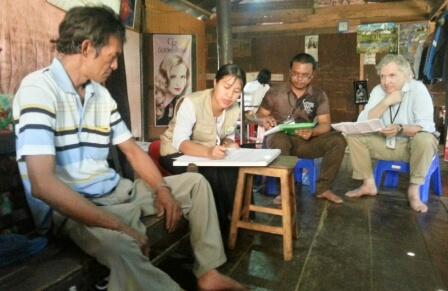46 International observers along with national counterparts carried out an important monitoring mission of this year's landmark Myanmar census which took place between 30 March to 10 April across all of the country's 15 states and regions to ensure that the population count, the first in over three decades was conducted correctly and according to international standards.
UNFPA met up with the two observers as they arrived in Falam Township for the last leg of the data collection exercise. “Before we sit in on an enumeration we first ask permission from the head of household. So far everyone has kindly agreed to let us observe the data collection in silence,” said Mr. Haug.
He went on to say that “What we have seen until now is impressive and the census in Chin state seems to be well organized. We have not faced any difficulties so far and I’m sure the census in Chin State will be of a high quality.”
When asked about how he compared the Myanmar census to other censuses he had observed, he stated that: “In Myanmar the communities are eager to participate. However this is not the case in most other countries, where census taking is often seen as a burden. Here it becomes an event, which everyone seems to want to be part of. I also found that the quality of the enumerators were high, due to their five day long training.”

In response to what he had found different from other data collections he had witnessed, Mr. Haug noted that “Women really are the face of the census. All the enumerators are women and they are doing an excellent job. They handled the questionnaire forms with great care, much more so than I have seen in other censuses… Women are also the caretakers of the households and in many ways they know more about their families, such as when someone was born or recent happenings in the communities. So they really are the face of the household. I find this impressive.”
Chin is one of the poorest regions in the country with high levels of migration. According to Mr. Haug approximately one fifth or even one third of the population is currently living outside of the state. This means that many of the households are, to a large degree, living of remittances from outside. “It will be very interesting for the future development of the region to understand the migration pattern, as well as the household composition. I noted that in many households many have family members with diseases that keep many of the women at home to care for them. This can also result in families having many children.”
“We don’t have any accurate data so the census is going to be the used as the baseline for our future development of our country,” said Johan Daw Lian, national census observer, who joined Mr. Haug in Chin State.
Upon complication of their mission to Chin State, they joined the other 44 observers in Yangon to exchange their findings and draft recommendations and lessons learnt. This was jointly presented to the Government of Myanmar on Friday (11 April 2014).
The Myanmar census ran from 30 March to 10 April 2014.


